There’s an old apartment building in South Minneapolis that looks totally out of place. It’s in a residential neighborhood with small bungalows and some auto body shops. And in the early 1900s, it used to be part of an amusement park called Wonderland. The park’s biggest attraction wasn’t the roller coaster, or the dance hall, or the log flume. It was a sideshow called “the Infantorium.” Visitors would pay ten cents to enter a spacious room full of glass boxes that were incubators with tiny premature babies on display. But despite how weird this whole concept might seem today, this wasn’t the only place this was happening. According to Lauren Rabinovitz, an amusement park historian, at the turn of the century, incubators for premature babies were widely available at fairs and amusement parks across America, rather than hospitals. Many parents of premature, at-risk babies pretty much had to bring their infants to an amusement park. And these infant shows were the main source of healthcare for premature babies for over forty years.
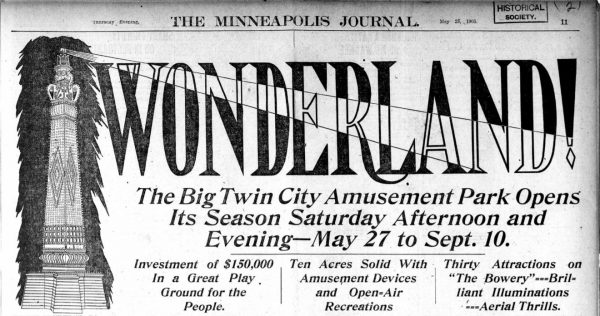
Lion’s Hatchery
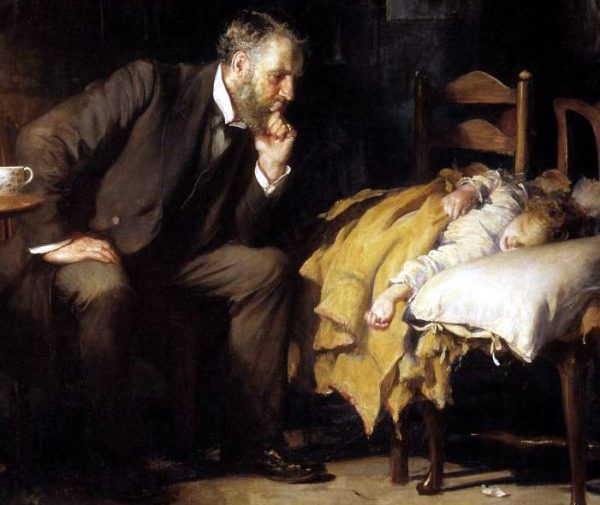
In the late 1800s, the world was a lot deadlier. Almost one in five babies in the United States died before childhood — which was an improvement from the previous decades. At the turn of the century, 19 out of 20 births were still happening at home. Which isn’t a problem, if the baby is healthy. But not all of them were. Like today, a lot of babies were born too early, yet the majority of American hospitals had nothing to help them. No technology, no special skills. There was no central heating to keep them warm. Doctors would place heated bricks in cribs and cross their fingers.
In private, people tried everything to keep premature babies alive. But more than three-quarters of premature babies were dying. And, in America, no one in the medical community was standing up for them. But things looked different over in France. There, doctors stole an idea from the poultry industry, which used incubators to hatch chicken eggs. They designed a human incubator. Basically, it was a warm box, heated by a hot water tank below. In the 1890s, a Frenchman named Alexandre Lion modernized the technology.

Dawn Raffel, the author of a book about the unexpected history of incubation in America, says Lion built a better incubator and displayed it at the Berlin Industrial Exposition in 1896. The air in Lion’s incubator was heated underneath by a pipe flowing with hot water. The temperature was pretty consistent, and the box was ventilated. But Lion’s real innovation had nothing to do with hot water or warm air. He put a big glass window on the box, and then in Berlin, he filled the boxes with premature babies. “It took on the environment of a sideshow,” says Raffel. “There were drinking hall songs about it. He called it Die Kinder-Brutanstalt, which was literally child hatchery.”
Dr. Couney
Some carnival showmen bought knock-off machines based on Lion’s design and started charging entry to their own premature baby shows. But raising a baby is not easy, and most of them got out of the business quickly. One showman, however, was hooked on this idea. In 1897, Dr. Martin Couney put on his first incubator baby show in London. Unlike the other showmen, Couney’s show had more of a refined air. He hired nurses to hold the babies and feed them breastmilk. The show was a hit so Dr. Couney decided to give it a try in the United States at the Omaha World’s Fair.
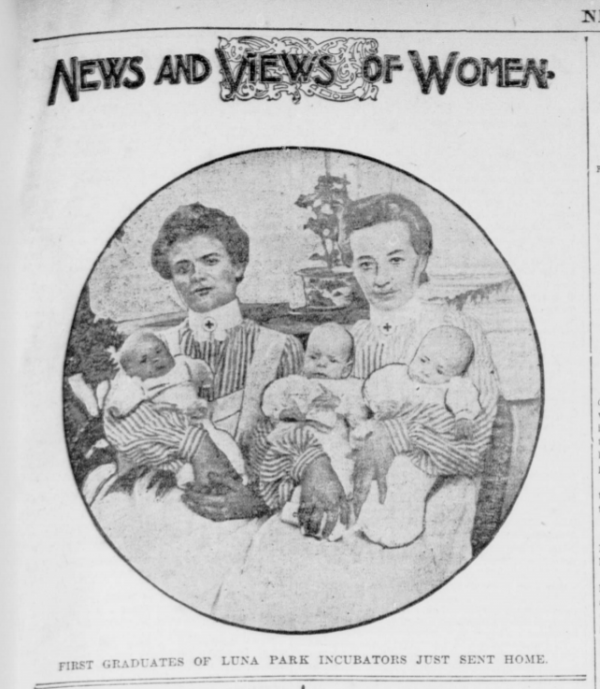
Couney perfected his sideshow at the 1901 World’s Fair in Buffalo, New York. That Fair has gone down in infamy as the place where President William McKinley was shot and died of gangrene 8 days later. But aside from that… people had a really good time at the fair! Dr. Couney set up on the midway, which is the section filled with carnival rides and sideshows, and in Buffalo, it was popping off with attractions like “House Upside Down,” and “Jerusalem on the Morning of the Crucifixion.” Thousands of people paid ten cents each to see Dr. Couney’s incubator show. And parents from across the city brought their premature babies to Couney, hoping for a miracle. A local medical journal reported that 48 of the 52 babies delivered to Couney that summer had survived.
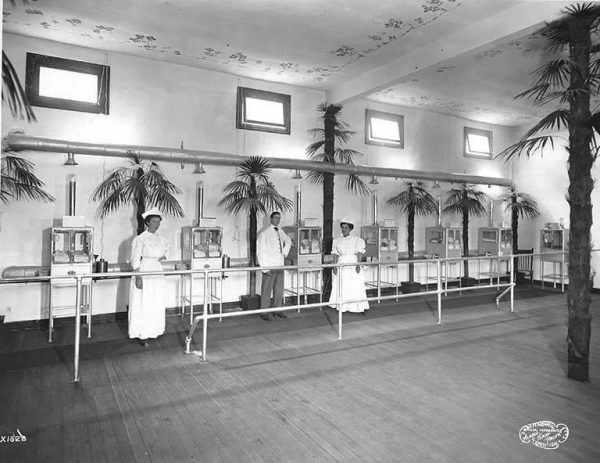
Coney Island Couney
That year, a new fad was sweeping the country that would prove a boon to Dr. Couney: amusement parks. The parks took all the excitement of fair midways and institutionalized it—every summer, the same city, the same place. By 1910, every US city with at least 20,000 people had its own amusement park. The attendance at theme parks was astronomical and could draw in a quarter of the population on a weekend.
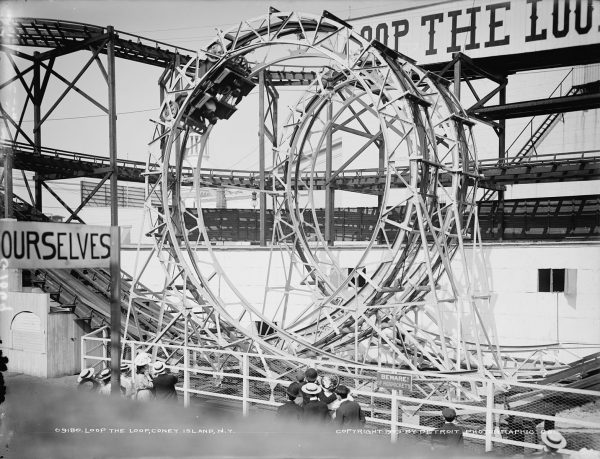
The rise of amusement parks also helped Americans become accustomed to new technology. Electric trains and motors made a lot of people uneasy, and new innovations often lead to accidents. But when people got on thrill rides or watched firework displays in the parks, they saw that technology could be fun and safe. In a way, Dr. Couney’s incubator babies were the essence of amusement parks.
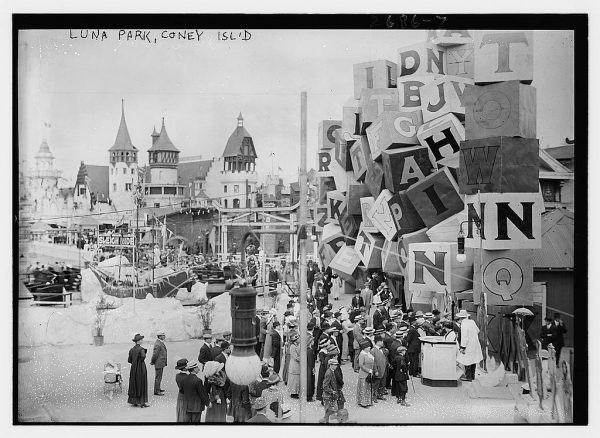
Couney’s display in Buffalo had caught the eye of two businessmen who were planning to build a new park in Coney Island. While that neighborhood already had two amusement parks, this new one, ‘Luna Park’, was bigger and better. It featured over 250,000 electric lights and a flagship ride called “A Trip to the Moon.” In the center of the rides and attractions was Dr. Couney’s futuristic Infantorium.
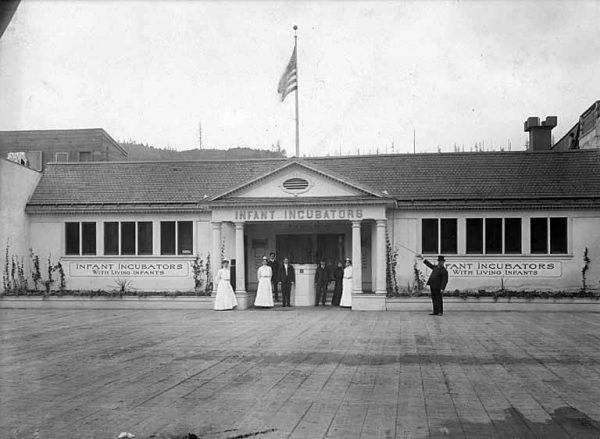
Won’t Somebody Please Think of the Children?!
In the spring of 1905, Couney traveled to Chicago, Denver, and Minneapolis to set up new exhibits. While the new exhibits made Dr. Couney rich, he also made a lot of decisions not driven by profit. Saving babies became Dr. Couney’s mission, as he would tell many colleagues. In his travels, Couney would often wine and dine other doctors, and give them demonstrations of the incubators. On multiple occasions, Dr. Couney tried to donate his incubators to local health departments after the local fair was over, but no one would take them. Doctors had all sorts of reasons for rejecting the technology. One reason was the disgraceful influence of the eugenics movement. In 1901, an anonymous editorial made the rounds in medical journals, disparaging the incubators. The author wrote that the human race suffered by keeping alive babies who the medical community literally referred to as “weaklings.” The author lamented Couney’s babies would “transmit their deficiencies, deformities and vices” to the next generation. Eugenics was hateful pseudoscience. And it was not a fringe movement. A lot of the fairs where Couney showed his babies also featured eugenics exhibits.
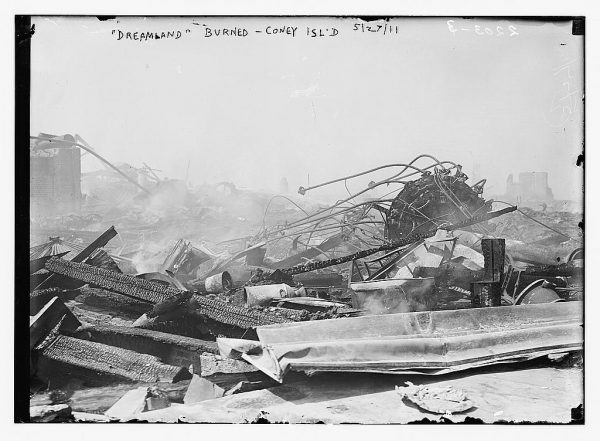
There were lots of other concerns about Couney’s approach. Many were concerned that amusement parks weren’t safe. One time in 1911, a Coney Island park with one of Couney’s shows went up in flames. The staff of doctors and nurses were able to save all the babies, but the incident only solidified the fear that these parks were too hazardous. Many of the parks were built quickly and were pretty shoddy. Four years earlier, a different park at Coney Island also burned down, and it burned down again in 1936 and again in 1939. Luna Park burned down in 1944. Around this time, amusement parks all over the country were going up in flames.

Beyond the safety concerns, there’s something deeply unsettling to modern eyes about the whole concept of incubator sideshows. Today, it’s clear that putting babies on display and profiting off of them is exploitative. In many ways, Couney’s exhibits were in line with some of the worst parts of amusement parks and World’s Fairs. In addition to the rides, many fairs and parks had “ethnological villages”, where Native Americans or people from faraway nations would live on-site in stereotyped caricatures of their homes. Some were literally caged and incarcerated on the grounds, with no record of payment. On a lot of midways, there was a despicable willingness to exploit human life for the entertainment of others. Charging money to see tiny infants was a small part of that.
Mr. Couney?
On top of the many ethical concerns with his work, there’s one more detail that makes historians uneasy about Martin Couney. He wasn’t actually a doctor. Couney had always told his staff that he had a license to practice in Europe, but it just hadn’t transferred to the US. The young doctors and nurses didn’t seem to mind. They followed his instructions, the babies lived, and he worked magic with the media and passersby. Even though Martin Couney was a fraud, that doesn’t mean his contribution to medicine was invalid. The babies in his care were more than four times as likely to survive into childhood. He took in babies of all races and classes, and he never once charged the families. Everything was funded by admissions. Money couldn’t buy better care — because there really wasn’t better care available.
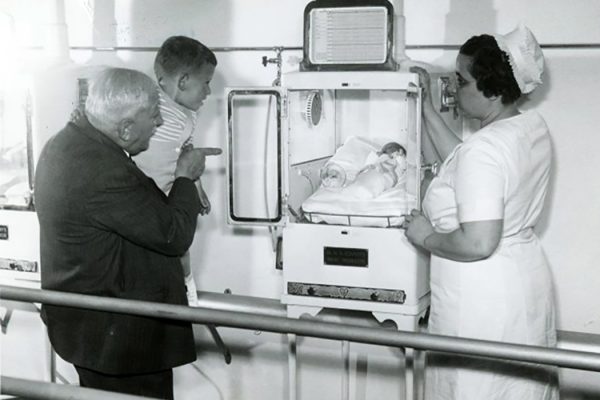
The Father of Neonatology
After 35 years of Couney’s incubator exhibits, his sideshow was still the best place in many cities to keep a premature baby alive. By the 1930s, most hospitals still hadn’t created alternatives to Couney’s infantoriums so people kept bringing their newborns to the midway. Then, in the depths of the Great Depression, incubators finally made a breakthrough when Martin Couney teamed up with a sympathetic medical practitioner in Chicago named Dr. Julius Hess.
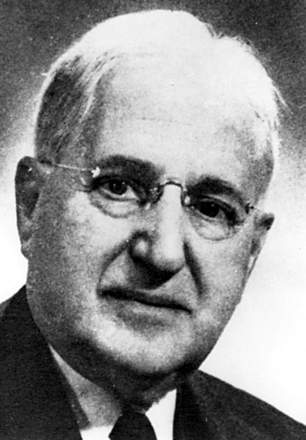
When Chicago hosted the World’s Fair in 1933, Couney’s exhibit had the explicit support of Dr. Hess. And that carried a lot of weight. Even Chicago’s health commissioner got on board. The Fair ran for two summers–and in the second summer, they held a baby reunion event, where joyous mothers carrying one-year-old babies strolled down the midway. Each baby had been saved by the incubators just one year earlier.
After the fair, Chicago became the first city in America to create a public health policy specifically for premature infants. Dr. Julius Hess became known as the “father of American neonatology.” And with the blessing of the Chicago medical community, other cities started putting incubators in their hospitals, too. As doctors got on board, there wasn’t much need for Couney’s sideshow. By the 1940s, Coney Island was his last amusement park exhibit taking babies. And some of those babies are still alive today.
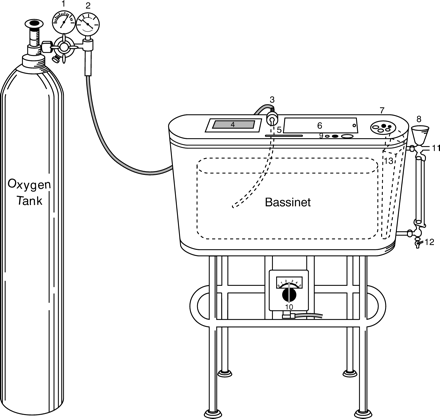
Beth Allen was born in Brooklyn in 1941, and she was one of the last premature babies to be treated by Couney. Although her mother was originally against taking her child to be treated as a sideshow, she was eventually persuaded to accept care. “The doctors, the doctors didn’t want it. They felt that the babies were weaklings. Either they lived or they died and nobody made any great effort to save them,” says Beth.
Couney sunk all of his savings into keeping the incubators shows operating in New York. In 1943, a New York hospital opened the city’s first department for premature infants. Martin Couney told his family that his job was done, and he closed up shop at Coney Island later that year. He got checks from sympathetic doctors like Julius Hess. But seven years after his last show, Martin Couney died penniless. Beth Allen’s parents were at his funeral. Beth was just one of the 7,000 amusement park babies to come out of Couney’s 45-year tenure as the sideshow doctor. Despite everything, Martin Couney’s attraction saved babies across America, kept alive for our amusement.



Comments (11)
Share
Fascinating, unbelievable story, especially hearing it two weeks after the birth of my child in a modern hospital.
Thanks for your podcast – my favorite series.
Katie Thornton’s summation was a bit harsh. The emphasis is misplaced. Rather than saying that these babies were freak shows for 45 years, I would lay the blame where it should be properly be laid — at the feet of the medical profession. They are supposed to save lives not take them. These amusement parks provided a reprieve from the sentence of death handed down to them from the medical profession. Thanks to society’s willingness to accept the incubators in amusement parks, over 7,000 people were rescued from death.
Agreed. The facts are fascinating, but this episode had a bad case of The Morals.
Thank you for saying this. Her final line, “… kept alive for our amusement,” really rubbed me the wrong way. Despite knowing that this man, at great financial cost to himself, found a way to hack the system at that he can save children’s lives, she still implied that this was the reason he did this at all. By the way, these infants had no clue that they were on display any more than the infants behind the glass at any NICU today. If I had a child then with no other alternative but to let them die, I’d bring them there in a heartbeat.
I found the coda particularly weird in how the Dionne quintuplets are presented as if most people have never heard of them. Seriously?! Who has never heard of the Dionne quintuplets?! It seems Katie Thornton hadn’t heard about them so she just assumed everyone else had this particular gap in knowledge. She also left out and kinda misrepresented or perhaps simplified aspects of their story … like the whole political/cultural conflict between French Canadians and English Canadians and the Catholic vs Protestant thing.
I’ve never heard of Dionne quintuplets. I suspect it’s definitely a by-country thing, and whether you read tabloids. I doubt many people have ever heard of them, I think you’re just unusually well informed about tabloid stories.
https://youtu.be/91Vj1T-lt7U
“Million Dollar Babies” is on YouTube. And seriously, just run a search of them and you’ll find tons of documentary video. And every time there is some sort of controversy with those reality shows that feature families with multiples, they bring up the Dionnes. It’s not like the Dionne quintuplets are this obscure story that isn’t well known. The treatment here was just plain weird!
They outsold the Shirley Temple 5 to 1 because there were five dolls you had to buy!
For what it’s worth, I’d never heard of the Dionne quints.
Hearing their story furnished an explanation for a Looney Tunes gag I’d puzzled over for years. In the 1946 cartoon Baby Bottleneck, Daffy Duck is fielding calls from anxious parents wondering why the stork hasn’t yet arrived. A call comes in on a long distance line and Daffy says “Who? Oh, Mr. Dionne! What?” Then a pause followed by a rather indignant “Mr. Dionne, puh-lease!” delivered directly to the audience.
Thanks for an excellent episode, really enjoyed it and will be on my mind for quite awhile.
I agree with several of the comments above that the episode was heavy-handed in trying to tell me what to think about the infantoriums. I recognize that this is the cultural moment we’re in where everyone’s terrified of being accused of supporting or turning a blind eye to injustices or not being woke enough. But expecting the 1930s to conform exactly to 2019 values is not realistic. 2019 values will surely look ridiculous to someone in 2100. For example, people in the future dealing with catastrophic climate change might be outraged that supposedly progressive people in 2019 flew all over the world to lie on beaches and spend leisure time. Of course, these infantoriums wouldn’t be acceptable today but within the values of the 1930s, they saved a lot of lives. That said, yes, violent racial and other social attitudes back then should be called out, but expecting people from 80 years ago to always conform to present-day values assumes that our values are some sort of perfect, end point of moral evolution that people throughout history should have inherently known. This episode hit a nerve with me in taking what I consider a rather arrogant attitude I see a lot these days.